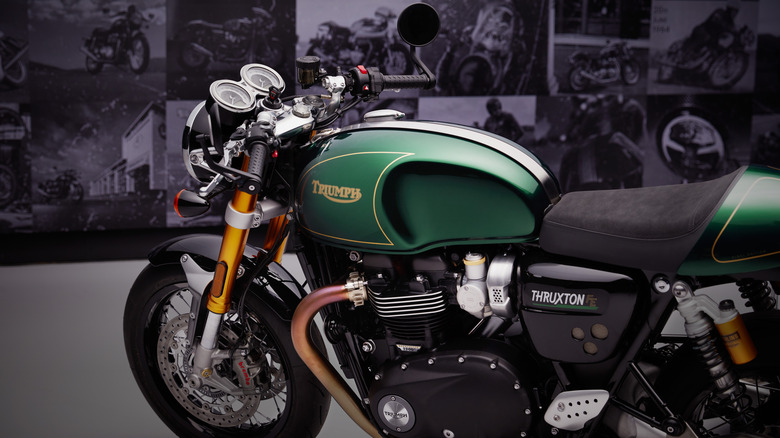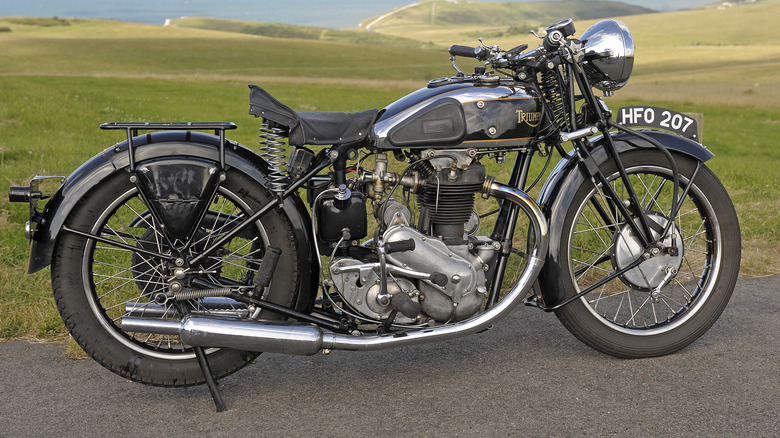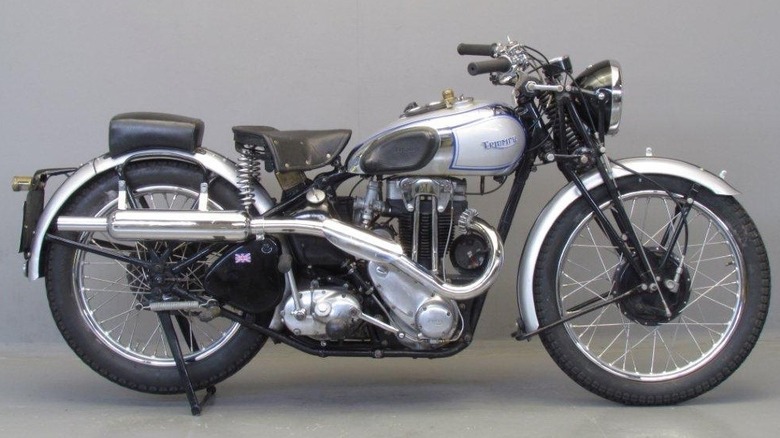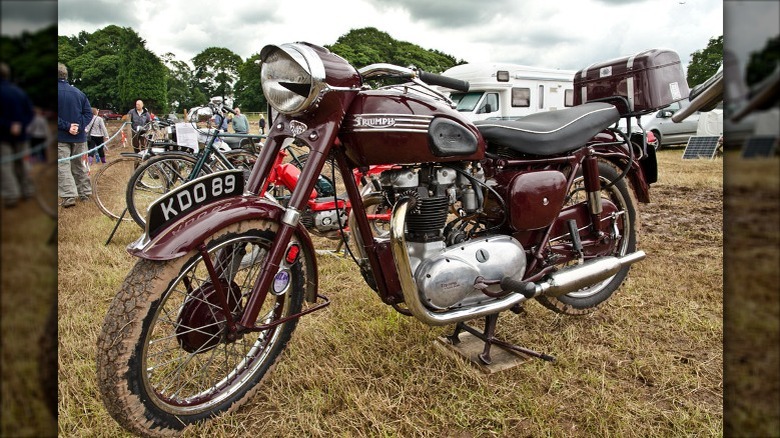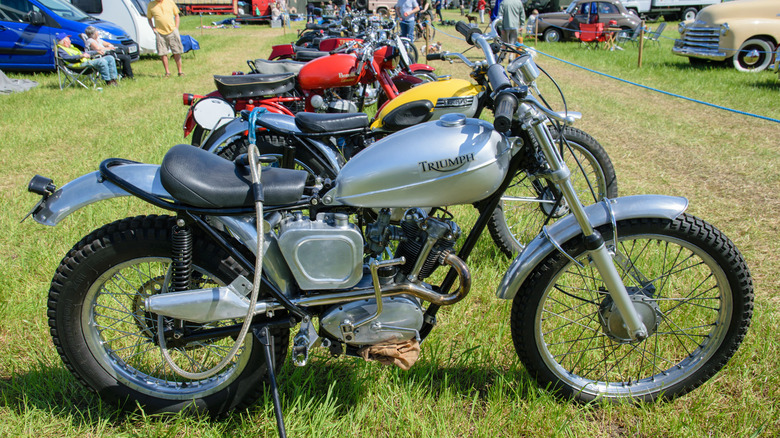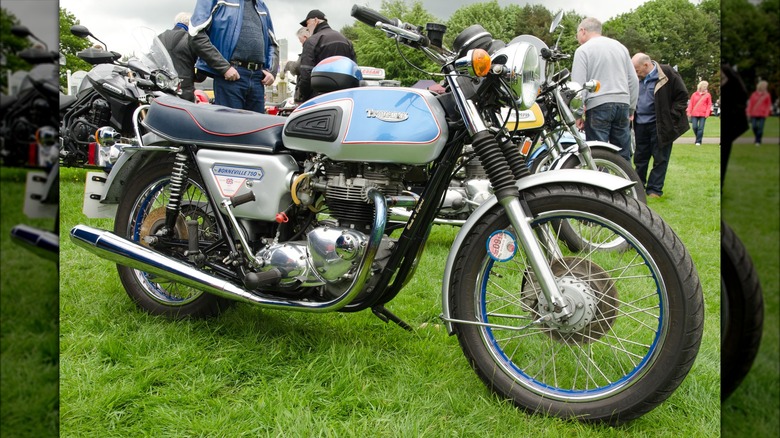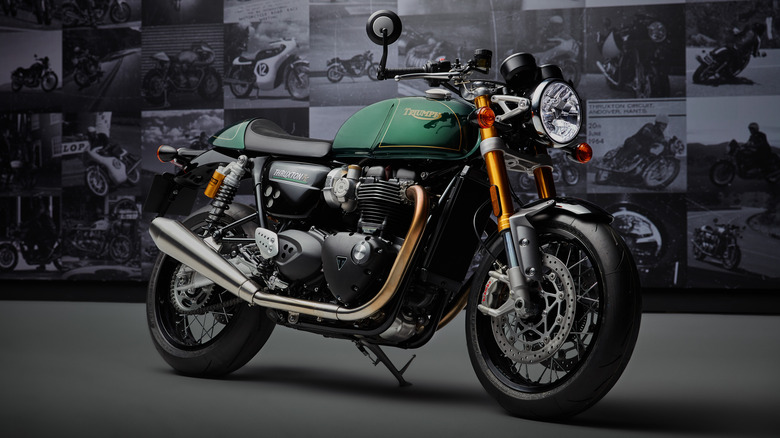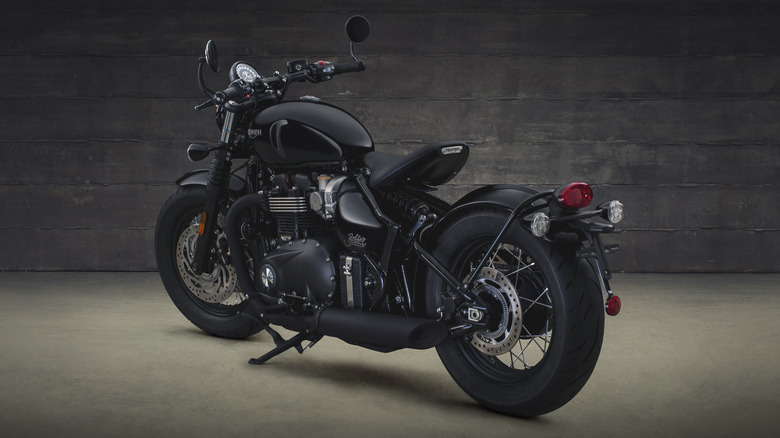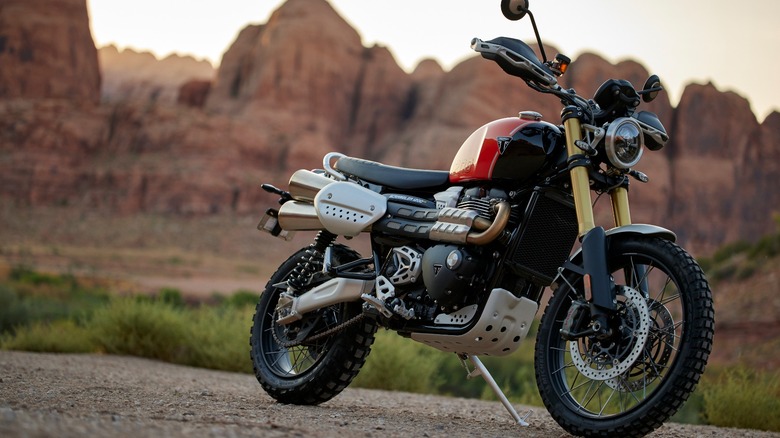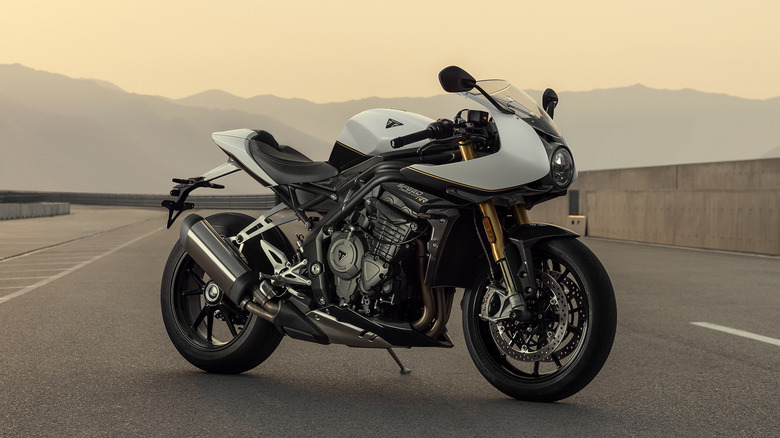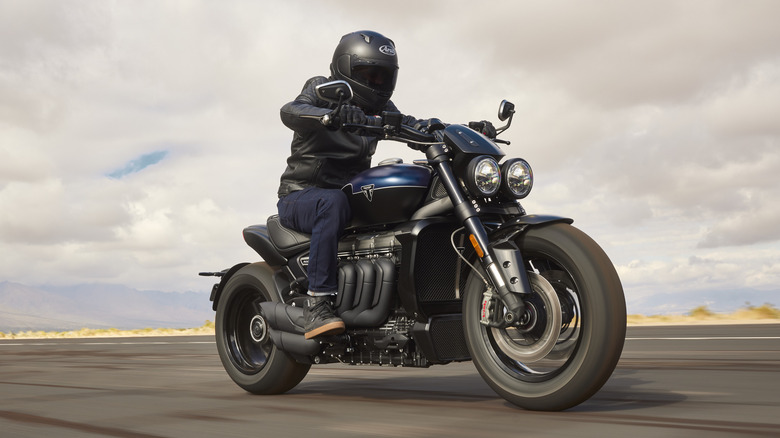10 Of The Most Stylish Triumph Motorcycles Ever Designed
Triumph is one of the most storied and long-lived motorcycle brands, with a wealth of amazing motorcycles under its belt. Founded in England by German migrant Siegfried Bettmann in the 1880s, the company started as a bicycle manufacturer before releasing its first-ever motorcycle, the Triumph No. 1, in 1901. The company would survive two World Wars, several changes of administration, and even bankruptcy in 1983, reemerging from the ashes under new ownership in 1991 and continuing the original company's legacy of making great and stylish motorcycles since then.
Like fellow British manufacturer BSA, Triumph's pre-World War II motorcycles were minimalist affairs, with exposed engines and not much bodywork. But despite their apparent simplicity, Triumph's offerings often had a certain something to them, from the subtly pleasing proportions of bikes like the Triumph 6/1 to more obviously eye-catching design characteristics like the Speed Twin's Amaranth Red paint or the Tiger 80's high, upswept exhaust.
Barring the occasional jaunt into sports bike-styled designs with offerings like the Daytona, the modern Triumph has generally retained the characteristics of its vintage bikes, with most of its products boasting naked (or semi-naked) café racer-inspired designs that blend the best of old and new to create some genuinely beautiful motorcycles. Prepare to be impressed as we go through 10 of Triumph's most stylish motorcycles ever.
1934 Triumph 6/1
The Triumph 6/1 was the company's first twin-cylinder model, preceding the iconic — and better-known — Speed Twin by five years. The 6/1 was a four-speed motorcycle with a 649cc engine capable of producing 25 hp, with an estimated top speed of 85 mph. Tame numbers now, but consider that Harley-Davidson's RL from 1935 only had a three-speed, made 8.5 hp, and topped out at 70 mph, and you'll have an idea of what an achievement the 6/1 was for its time.
The 6/1's impressive performance meant it did well in competition, finishing second in 1933's International Six Days Trial and succeeding at the Brooklands 500, where the bike covered 500 miles in 498 minutes. Both achievements helped Triumph win the Maudes Trophy in 1934 — an endurance accolade for motorcycles, most recently won by Zero Motorcycles and its DSR/X electric bike. But the 6/1 wasn't just a mechanical marvel: With its cropped spring seat, minimalist design, and industrial-looking girder front suspension, the 6/1 was a stylish example of pre-World War II motorcycle design.
However, despite its proven performance and durability, the Triumph 6/1 wasn't all that successful. Its price — double that of some of Triumph's other motorbikes — likely didn't help. Triumph sold fewer than 600 examples during its two-year production run, and fewer than 25 are thought to have survived. This makes the Triumph 6/1 not just a great-looking motorcycle, but an exceedingly rare one.
1936 Triumph Tiger 80
Triumph's pre-war motorcycles were some of the most elegant around, and 1936's Tiger 80 is one of the best examples. The Tiger 80 was a 349cc single-cylinder motorcycle that made 20 hp, which was enough power to push the 320-pound bike to an 80-mph top speed, after which the model was named. The Tiger 80 had more to give, though, and the chief of Triumph's technical department at the time, Freddie Clarke, took a modified example to a dizzying 105.97 mph at Brooklands circuit.
However, the Tiger 80 was also a great-looking bike. The fuel tank is beautiful, with blue and grey art on a polished chrome base accentuating its rounded shape. There's the typical short seat and girder front suspension, with exposed springs lending an air of ruggedness to the bike. But the highlight has to be the eye-catching exhaust pipe, which sweeps up from the engine and exits well above the rear axle.
Unfortunately, the Tiger 80 was a short-lived bike: A German air raid took out the Coventry, U.K. factory in 1940, destroying most of the company's records and designs. The company repurposed the Tiger 80 into the 3HW for wartime use, but the Tiger 80 itself never returned to production. Once the war ended, Triumph elected to focus primarily on twin-cylinder bikes, although the Tiger name survived on motorcycles such as Tiger 85 and the Tiger 100, one of the most reliable vintage bikes ever built.
1938 Triumph Speed Twin
In the annals of British motorcycles, few are as influential as Triumph's Speed Twin 5T. Debuting in 1938, the Speed Twin ushered in the era of parallel twin engines with its 497cc, 28.5-hp twin-cylinder engine, although contemporary buyers wouldn't have known that. Designer Edward Turner intentionally made the engine look like a twin-port single-cylinder engine to avoid the wrath of conservative Triumph customers.
When it debuted, the Speed Twin looked similar to its single-cylinder counterparts, with the same minimalist, spring-heavy design thanks to its seat and girder suspension. It also had the same visually pleasing proportions, looking great from almost any angle. However, what makes the Speed Twin special is the color: Triumph's Amaranth Red isn't just a beautiful color, it also set the bike apart from its stablemates, allowing it to look both retro and surprisingly modern even now.
Unlike many of Triumph's pre-WWII motorcycles, the Speed Twin survived the break in production enforced by the war. It returned to the Triumph catalog in 1946, boasting new telescopic front forks and a rudimentary rear suspension system called the sprung hub. Triumph continued to build the Speed Twin well into the 1960s, although its last few years were marred by a protective steel tub covering the rear wheel. Triumph discontinued the original Speed Twin in 1966, but resurrected the name in 2019.
1954 Triumph Tiger Cub
Triumph's post-WWII production may have focused on parallel twin bikes, but when rival manufacturer BSA succeeded with the single-cylinder Bantam, Triumph knew it couldn't ignore that part of the market. As a response, Triumph introduced the 150cc T15 Terrier in 1952 before following it up with the Tiger Cub in 1954.
The Tiger Cub was a 200cc single-cylinder, four-stroke motorbike with 10 hp and a top speed of 67 mph. The Tiger Cub's four-speed transmission was built into the engine, and it sat inside an ultra-light frame with front and rear drum breaks and an integral fuel tank. It wasn't a particularly advanced bike, but contemporary reviewers praised its suspension and engine, which, coupled with its low price, made the Tiger Cub a hit at home and abroad.
Triumph produced the Tiger Cub for nearly 15 years, with the last models rolling out of the factory in 1968. Across that production span, Triumph made several versions of the Tiger Cub, all sharing the base Tiger Cub's minimalist cool — although the Cub wasn't immune to the strange rear tub craze, with one introduced to the bike in 1958. All the non-enclosed Tiger Cubs look great, but our vote for the best-looking Tiger Cub model is the TR20 Trials Tiger Cub. The Trials takes the Tiger Cub formula but elevates it with knobby tires, a clean silver finish, and high exhaust — all very practical, but also very cool.
1977 Triumph Bonneville T140J Silver Jubilee
The Bonneville is probably Triumph's best-known nameplate, debuting in 1959 and continuing to this very day in the form of the 1,200cc Bonneville T120 and the severely underrated Bonneville T100. But while almost all of Triumph's Bonneville bikes are lookers — yes, even the much chunkier modern descendants — one stands head and shoulders above the rest: the T140J Silver Jubilee.
Triumph introduced the T140 Bonneville in late 1972 to satisfy American importers. Initially sporting a 724cc engine, the T140 gained an extra 20cc in December of that year, making for a 744cc, 52 hp engine that Triumph mated to a five-speed transmission. Other updates included a front disc brake — later extended to the rear in 1976 — and Girling shock absorbers.
In 1977, Triumph introduced the T140J Silver Jubilee edition to celebrate the 25th year of Queen Elizabeth II's reign. The T140J was mechanically identical to the T140 but featured a new paint job, with a silver base complemented by red, white, and blue stripes and color blocks. Triumph also went to town on the metalwork, with chrome-plated engine and transmission components.
The T140J was a one-year-only special, but Triumph continued producing the Bonneville until its 1983 bankruptcy. British builder Les Harris kept the Bonneville name alive with a run of licensed Bonnevilles from 1983 to 1988, but it would take until 2001 for the iconic Bonneville name to return as an official Triumph model.
2016 Triumph Thruxton
Triumph's Thruxton motorbikes had been around for more than a decade by the time the Thruxton R debuted in 2016, but Triumph saved the best for last when it came to its retro-minded offering. When it debuted, the 1,200cc Thruxton was a beautiful example of burly big-bike power — its engine made 96 hp and 83 lb-ft of torque — and retro-minded styling.
The 2016 Thruxton was a lean and mean machine, with a pitch-perfect design that evoked not just café racers, but also the clean simplicity of some of Triumph's pre-WWII bikes. But don't mistake simple for basic. The engine was a modern unit, with throttle by wire and electronic fuel injection in place of the carburetors of old, though Triumph designers opted to style the Thruxton's throttle bodies to look like carburetors — not the most authentic move, perhaps, but it helped the bike look the part.
Triumph continued to iterate over the next few years before discontinuing the motorcycle in 2024. It sent the Thruxton out with a bang, introducing a gorgeous Final Edition for its final run. Triumph went with a rich British Racing Green with tasteful gold highlights — including exhaust yellowing to echo the front shocks and striping. It's an absolute stunner. It's more than just a visual package, though: The Final Edition got a 104-hp engine, Showa and Öhlins suspension, and Metzeler Racetec RR rubber, all as standard — a fitting way to go for one of the best Triumph motorcycles ever made.
2017 Triumph Bonneville Bobber
Triumph's decision to resurrect the Bonneville was a huge success, helping the brand become the best-selling European marque in North America for the first few months of 2016. So it wasn't surprising that Triumph decided to expand the nameplate into then-unseen territory in 2017 with the Bonneville Bobber.
The Bonneville Bobber shared the Bonneville T120's 1,200cc engine, but with a Bobber-specific tune that increased horsepower output and torque in the low rev range. The Bobber made 76 hp and 78 lb-ft of torque in its first year, with no real changes in the years since — not that it needed more power, mind you. Reviewers enjoyed the engine, with its low-end power emphasizing the bike's cruiser mindset — even if the riding position was a bit too sporty for its own good.
Enough about the engine, though: Let's talk about the looks. The Bonneville Bobber has to be one of Triumph's best-looking modern motorcycles, combining Triumph's racer heritage with genuine bobber goodness. The hanging one-rider seat, bobbed fenders, and high-profile tires all scream cruiser — as does the one-headlamp front end — but the Bonneville Bobber retains that inimitable Triumph style, albeit in an even more minimalist fashion. All of these design features looked especially great on 2018's Bonneville Bobber Black, which was a mean, blacked-out take with an even thicker front wheel and bigger Showa shocks up front.
2024 Triumph Scrambler 1200
Triumph likely isn't a brand most will associate with off-road bikes, even if its off-road variants of the Tiger Cub and Bonneville arguably paved the way for modern dirt bikes. That all changed with the Scrambler, an all-seeing, all-doing bike that was — and continues to be — as good a daily ride as it is off-road. The Scrambler debuted in the mid-2000s, but for our money, the bike didn't quite reach its peak form until 2019's Scrambler 1200.
Available in two versions — X and XE — starting 2024, the Scrambler 1200 packs the 1,200cc Bonneville engine with a Scrambler-specific tune that makes 89 hp and 81.1 lb-ft of torque with a bevy of trick components, such as Marzocchi forks (adjustable on the pricier XE), Nissin brakes — or Brembo, on the XE — and a ride by wire throttle. The tech allows for a healthy selection of riding modes and rider aids, including ABS and traction control. The XE also has a bigger off-roading focus, with a dedicated off-road mode and extra wheel travel, thanks to a slightly different chassis.
Both Scrambler 1200 models are handsome beasts, with Triumph's signature sculpted fuel tank atop a clean, upright chassis and high-level twin exhaust pipes that evoke the high sweeping exhausts of older Triumphs like the Tiger 80. Both bikes look almost identical, although the XE-exclusive orange and black colorway is the best-looking of the bunch.
2022 Triumph Speed Triple 1200 RR
Triumph's Speed Triple 1200 RR is one of Triumph's most unique bikes, with a design that comes across as a hybrid between its old-school racer roots and its more conventional sports bikes like the Daytona 675 — albeit without the latter's famed unreliability. Up front, you get an old-school cockpit fairing, as Triumph calls it, but the tank and seating are all superbike, with their rakish and sporty angles. Even the exhaust points up in the style of the sleekest sports bikes out there.
As you might expect from a modern Triumph motorbike, there's more to the Speed Triple 1200 RR than its eye-catching looks. The three-cylinder, 1,160cc engine makes a healthy 177 hp and 92 lb-ft of torque, which Triumph pairs with an electronically-controlled Öhlins suspension that allows for several riding presets and rider aids, including braking assist for the Brembo Stylema brakes. Reviewers appreciated the Speed Triple 1200 RR's whole package, especially for road use, with the handling and engine's power delivery getting particular praise.
Another similarity between the Speed Triple 1200 RR and its Triumph stablemates is the presence of some great-looking limited-edition versions. Both the Breitling and Bond versions are achingly rare — 270 and 60 units, respectively — and genuinely beautiful, swapping the red (or white) of the standard model for darker metallic grey and black color schemes. Neither featured any major mechanical difference, although the Breitling version had a lighter titanium silencer from Akrapovič, which also looked much better.
2024 Triumph Rocket 3 Storm R
Triumph's Rocket 3 may be a newcomer to the Triumph lineup, but it quickly established itself as a top dog in the motorcycle world, not least thanks to its 2,458cc three-cylinder engine. The Rocket 3's massive powerplant — one of the largest displacement bike engines ever built — is something of a monster, with the latest iteration in the Rocket 3 Storm R making an astounding 180 hp and 166 lb-ft of torque.
The Rocket nameplate started with 2003's Rocket III — note the Roman numerals — and its 2,294cc engine, which Triumph later one-upped when it launched the all-new Rocket 3 in 2020. But there was more to the Rocket 3 than a new engine: Triumph developed an all-new chassis and ditched the old cruiser-style design. In its place was a much more aggressive look, complete with a naked rear end that made it look like a café racer on steroids.
Add in the in-your-face triple exhaust headers for the three-cylinder engine, and you get a muscular, high-powered visual style that perfectly matches the bike's capabilities. 2024's Storm R looks especially great in its Sapphire Black and Granite colorway, matching the black exhaust pipes for an almost blacked-out look that looks especially menacing. The new 10-spoke aluminum wheels are a great upgrade over previous Rocket 3, too, and the total package is a stylish one — if, admittedly, a little ungraceful.
